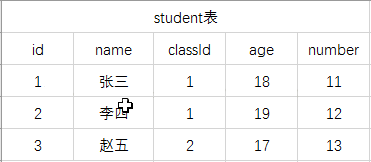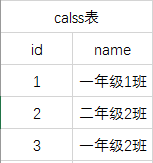您好,登錄后才能下訂單哦!
您好,登錄后才能下訂單哦!
本文實例講述了MongoDB多表關聯查詢操作。分享給大家供大家參考,具體如下:
Mongoose的多表關聯查詢
首先,我們回憶一下,MySQL多表關聯查詢的語句:
student表:

calss表:

通過student的classId關聯進行查詢學生名稱,班級的數據:
SELECT student.name,student.age,class.name FROM student,class WHERE student.classId = class.id
Mongoose多表聯合查詢(還是以眾所周知的學生、班級作為實例)
· 表結構的定義(schemas目錄下)
1. student表(student.js)
var mongoose = require('mongoose');
var Schema = mongoose.Schema;
/*定義數據模式*/
var StudentSchema = new mongoose.Schema({
name: String,
calssId: {
type: Schema.Types.objectId,
ref: 'class'
},
age: Number,
number: Number,
meta: {
createAt: {
type: Date,
default: Date.now()
},
updateAt: {
type: Date,
default: Date.now()
}
}
/*更新時間的*/
});
module.exports = StudentSchema;
2. class表(class.js)
var mongoose = require('mongoose');
var Schema = mongoose.Schema;
/*定義數據模式*/
var ClassSchema = new mongoose.Schema({
name: String,
meta: {
createAt: {
type: Date,
default: Date.now()
},
updateAt: {
type: Date,
default: Date.now()
}
}
/*更新時間的*/
});
module.exports = ClassSchema;
· 生成Model(model目錄下)
1. student Model(student.js)
var mongoose = require('mongoose');
var StudentSchema = require('../schemas/student');
/*通過model編譯模式為模型*/
var Student = mongoose.model('student', StudentSchema);
/*導出Student模型 模塊*/
module.exports = Student;
2. class Model(class.js)
var mongoose = require('mongoose');
var ClassSchema = require('../schemas/class');
/*通過model編譯模式為模型*/
var Class = mongoose.model('class', ClassSchema);
/*導出Class模型 模塊*/
module.exports = Class;
· Model進行數據的查詢操作
1. 將靜態類的方法加到Model的編譯中
StudentSchema.static = {
fetch: function(cb){
return this
.find({})
.sort('meta.updateAt') //按更新的時間排序
}
}
2. 將靜態類方法加到Model中
StudentSchema.static('fetch', function(cb){
return this
.find({}, cb)
.sort('meta.updateAt')
})
3. 直接調用model的find()方法
查詢的結果均為:
[
{
_id: '5a05222f583e5720b8660191',
name: '張三',
age: 18,
number: 11,
classId: '5a0036512b740f32e4371e66'
},
{
_id: '5a05222f583e5720b8660091',
name: '李四',
age: 19,
number: 11,
classId: '5a0036512b740f32e1371e66'
},
{
_id: '5a05222f583e5720b18660191',
name: '趙五',
age: 17,
number: 11,
classId: '5a0036512b7420f32e4371e66'
}
]
· 多表聯合查詢(學生對應班級)
StudentSchema.static = {
findStudentWithClass: function (cb) {
return this
.find({})
.populate('classId')//注意這是聯合查詢的關鍵
.sort('meta.updateAt')
.exec(cb)
}
}
查詢結果:
[
{
_id: '5a05222f583e5720b8660191',
name: '張三',
age: 18,
number: 11,
classId: {
_id: '5a0036512b740f32e4371e66',
name: '一年1班'
}
},
{
_id: '5a05222f583e5720b8660091',
name: '李四',
age: 18,
number: 11,
classId: {
_id: '5a0036512b740f32e1371e66',
name: '二年2班'
}
},
{
_id: '5a05222f583e5720b18660191',
name: '趙五',
age: 18,
number: 11,
classId: {
_id: '5a0036512b7420f32e4371e66',
name: '一年2班'
}
}
]
· 由上面的實例可知,mongoose的多表聯合查詢的關鍵:
1. 數據模式結構定義需要利用關鍵字ref定義關聯
var Schema = new mongoose.Schema({
field: {
type: mongoose.Schema.Type.ObjectId,
ref: 'model'
}
});
Schema.static = {
fetch: function(cb){
return this
.find({})
.populate('field')
.exec(cb)
}
}
var Model = mongoose.Model('model',Schema );
希望本文所述對大家MongoDB數據庫程序設計有所幫助。
免責聲明:本站發布的內容(圖片、視頻和文字)以原創、轉載和分享為主,文章觀點不代表本網站立場,如果涉及侵權請聯系站長郵箱:is@yisu.com進行舉報,并提供相關證據,一經查實,將立刻刪除涉嫌侵權內容。